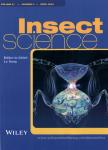Heterogeneous distribution of Cardinium in whitefly populations is associated with host nuclear genetic background
作者机构:Shandong Engineering Research Center for Environment-Friendly Agricultural Pest ManagementCollege of Plant Health and MedicineQingdao Agricultural UniversityQingdaoShangdong ProvinceChina Shenzhen BranchGuangdong Laboratory of Lingnan Modern AgricultureKey Laboratory of Gene Editing Technologies(Hainan)Ministry of Agriculture and Rural AffairsAgricultural Genomics Institute at ShenzhenChinese Academy of Agricultural SciencesShenzhenGuangdong ProvinceChina Key Laboratory of Bio-Pesticide Innovation and Application of Guangdong ProvinceSouth China Agricultural UniversityGuangzhouChina Department of Plant ProtectionInstitute of Vegetables and FlowersChinese Academy of Agricultural SciencesBeijingChina Department of EntomologyUniversity of KentuckyLexingtonKentuckyUSA
出 版 物:《Insect Science》 (昆虫科学(英文版))
年 卷 期:2023年第30卷第6期
页 面:1701-1712页
核心收录:
学科分类:0710[理学-生物学] 07[理学] 09[农学]
基 金:supported by the National Key R&D Program of China(2022YFD1401200) Taishan Scholar Foundation of Shandong Province of China(tstp20221135) the National Nature Science Foun-dation of China(31872030 and 31572064)
主 题:Bemisia tabaci Cardinium heterogeneity infection frequency nuclear genotype
摘 要:Inherited bacterial symbionts are very common in arthropods, but infection frequency can vary widely among populations. Experiments and interpopulation comparisons suggest that host genetic background might be important in explaining this variation. Our extensive field investigation showed that the infection pattern of the facultative symbiont Cardinium was heterogeneous across geographical populations of the invasive whitefly Bemisia tabaci Mediterranean (MED) in China, with genetic nuclear differences evident in 2 of the populations: 1 with a low infection rate (SD line) and 1 with a high infection rate (HaN line). However, whether the heterogeneous frequency of Cardinium is associated with the host genetic background remains poorly understood. Here, we compared the fitness of the Cardinium-infected and uninfected sublines with similar nuclear genetic backgrounds from SD and HaN lines, respectively, and further determine whether host extranuclear or nuclear genotype influenced the Cardinium–host phenotype by performing 2 new introgression series of 6 generations between SD and HaN lines (i.e., Cardinium-infected females of SD were backcrossed with uninfected males of HaN, and vice versa). The results showed that Cardinium provides marginal fitness benefits in the SD line, whereas Cardinium provides strong fitness benefits in the HaN line. Further, both Cardinium and the Cardinium–host nuclear interaction influence the fecundity and pre-adult survival rate of B. tabaci, whereas the extranuclear genotype does not. In conclusion, our results provide evidence that Cardinium-mediated fitness effects were closely associated with the host genetic background, which provides a fundamental basis for understanding the mechanism underlying the heterogeneous distribution of Cardinium in B. tabaci MED populations across China.



